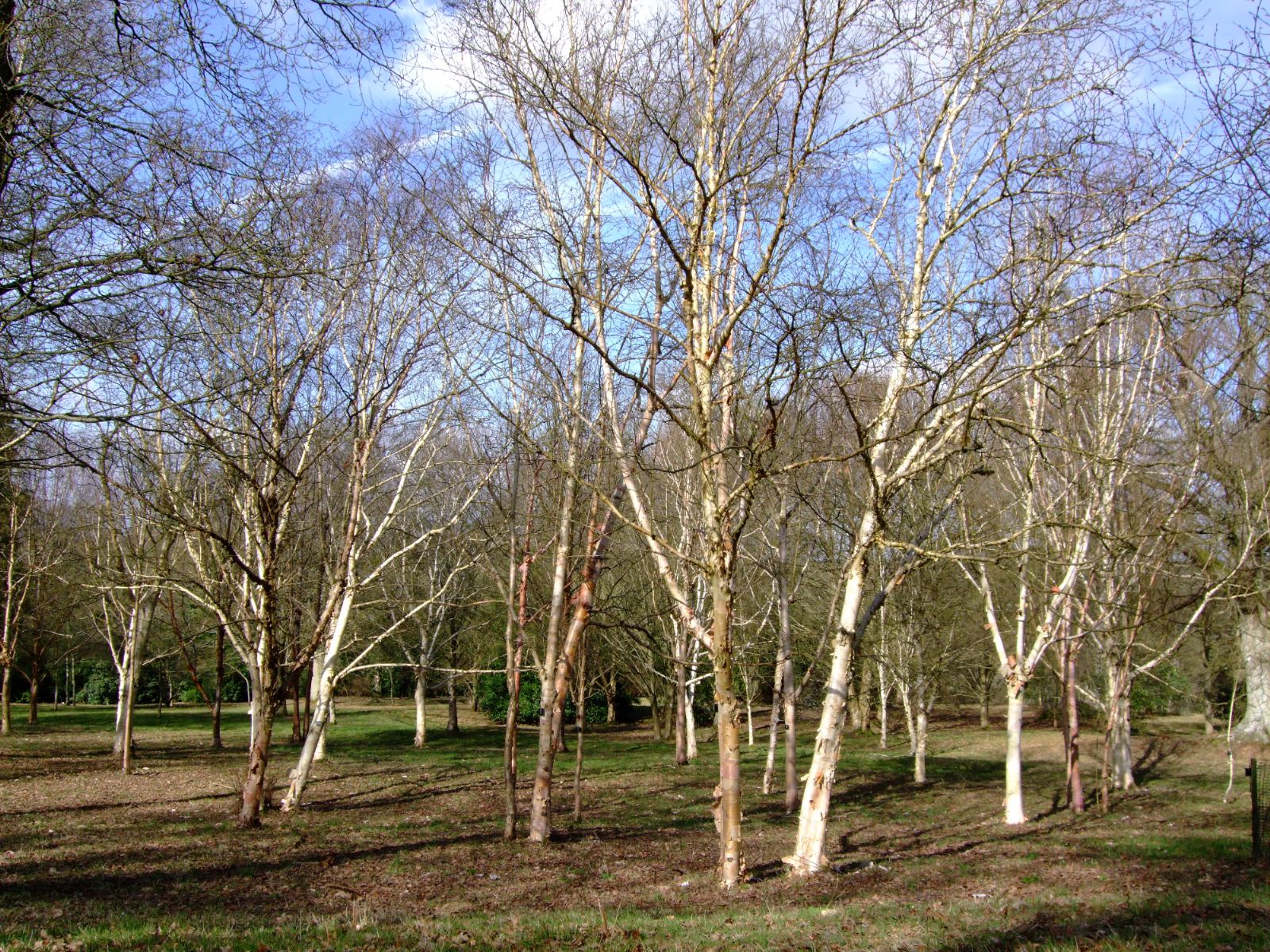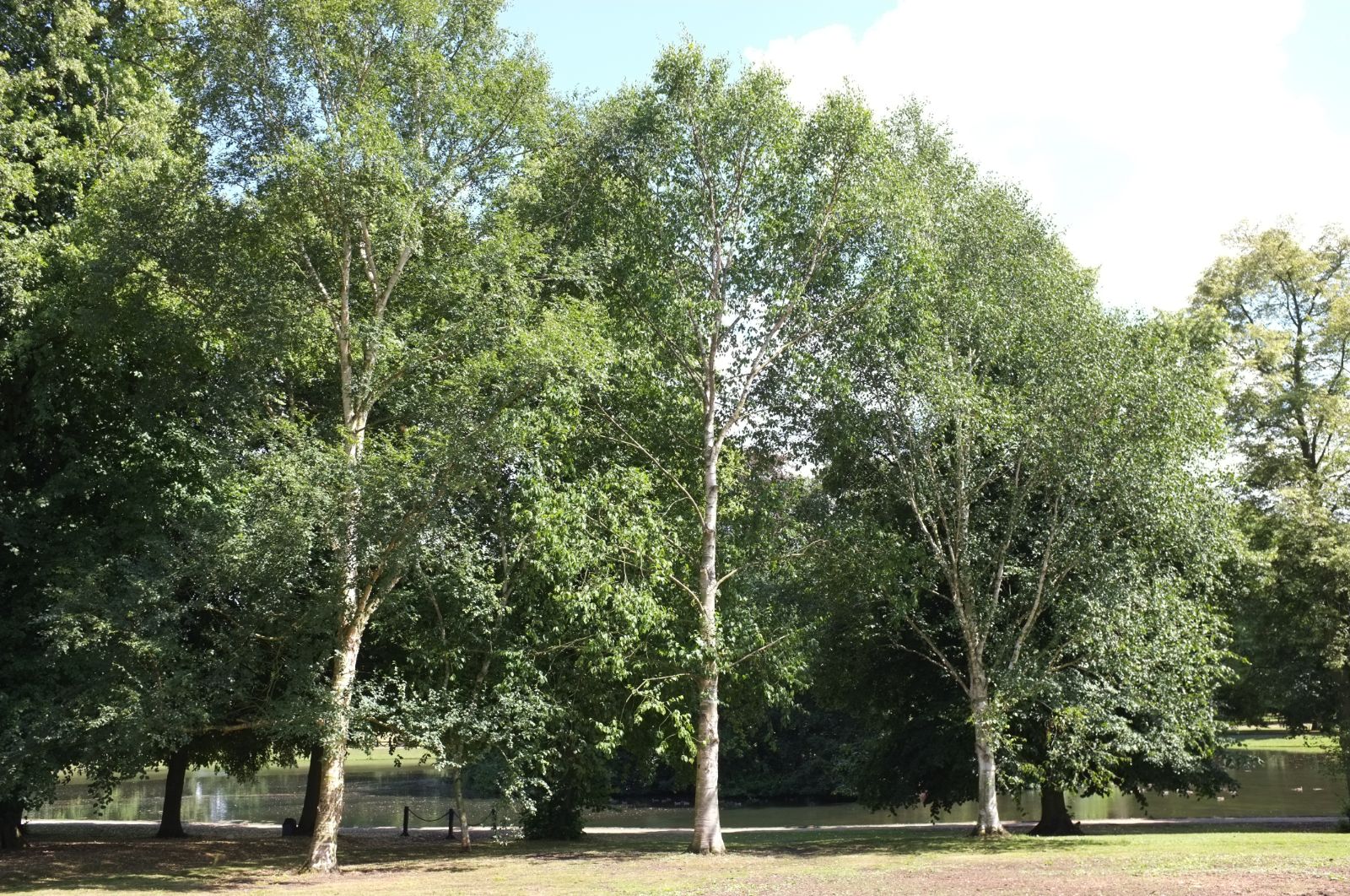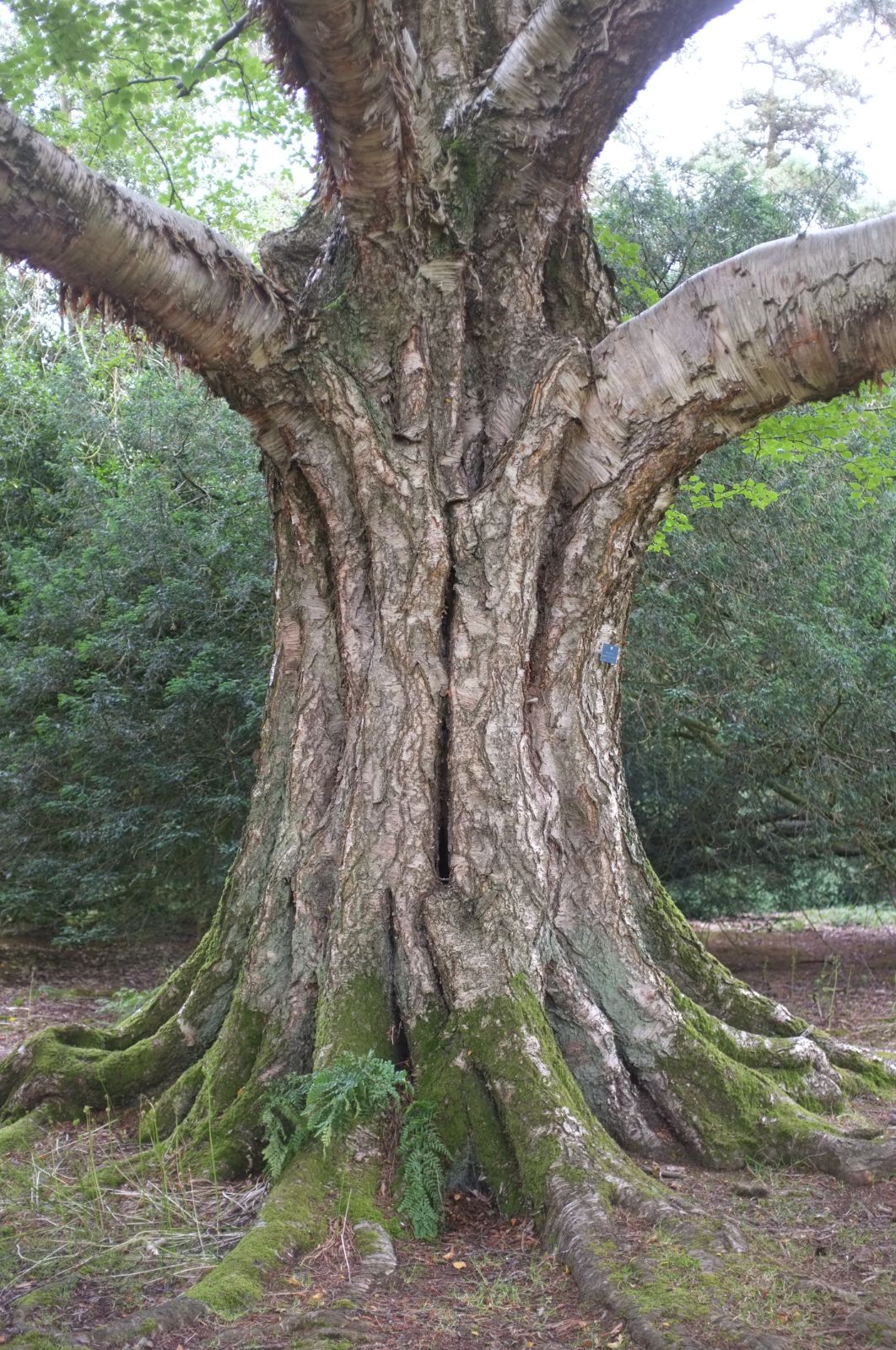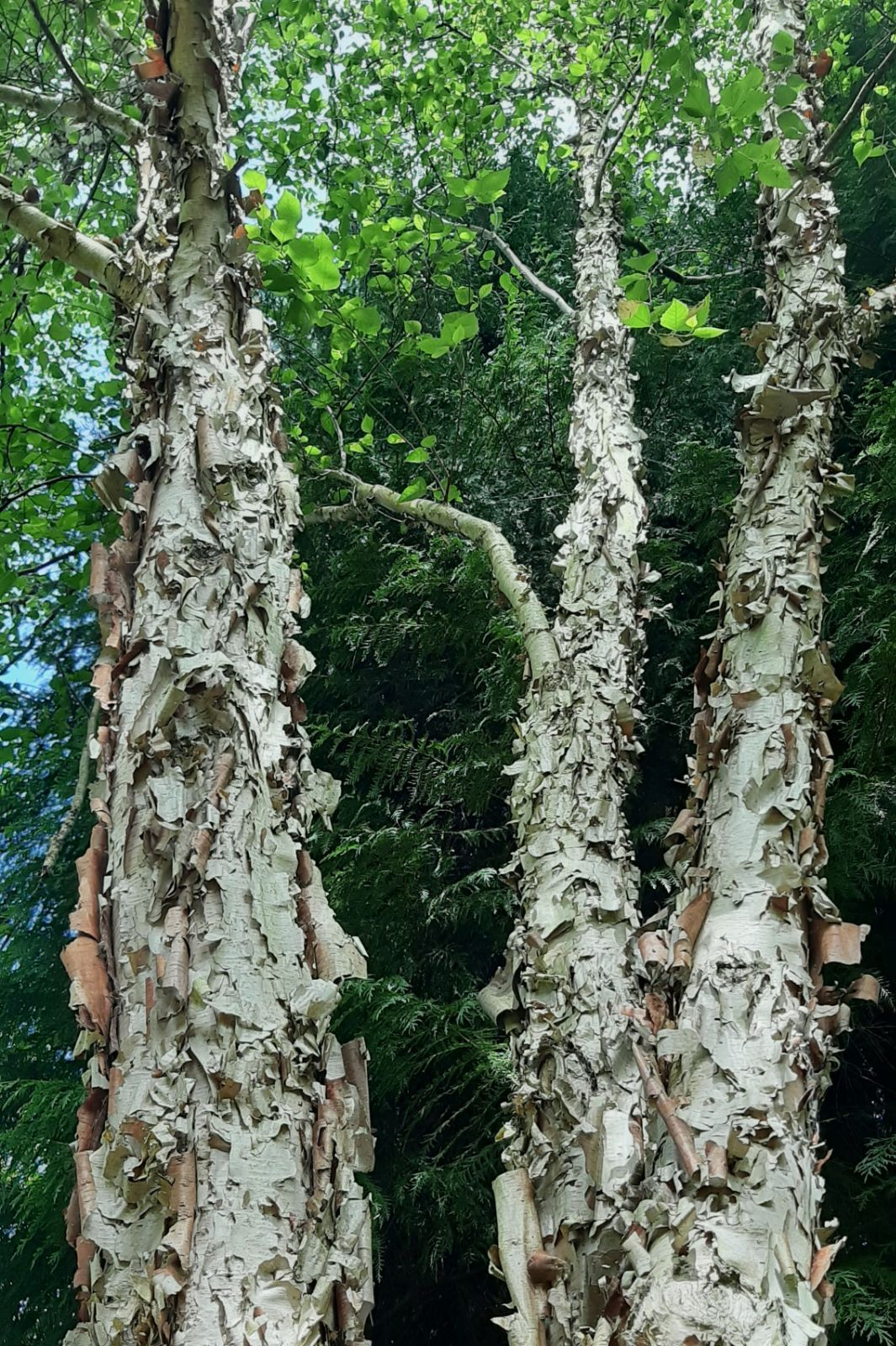Betula
Credits
Article from Bean's Trees and Shrubs Hardy in the British Isles
Article from New Trees by John Grimshaw & Ross Bayton
Recommended citation
'Betula' from the website Trees and Shrubs Online (treesandshrubsonline.
Family
- Betulaceae
Common Names
- Birches
Species in genus
- Betula albosinensis
- Betula alleghaniensis
- Betula × aurata
- Betula bomiensis
- Betula × caerulea
- Betula chichibuensis
- Betula chinensis
- Betula coerulea-grandis
- Betula cordifolia
- Betula corylifolia
- Betula cylindrostachya
- Betula davurica
- Betula delavayi
- Betula ermanii
- Betula forrestii
- Betula glandulosa
- Betula globispica
- Betula grossa
- Betula humilis
- Betula insignis
- Betula jacquemontii
- Betula lenta
- Betula luminifera
- Betula lutea
- Betula mandshurica
- Betula maximowicziana
- Betula medwediewii
- Betula nana
- Betula neoalaskana
- Betula nigra
- Betula occidentalis
- Betula papyrifera
- Betula pendula
- Betula platyphylla
- Betula populifolia
- Betula potaninii
- Betula pubescens
- Betula pumila
- Betula raddeana
- Betula schmidtii
- Betula szechuanica
- Betula tianschanica
- Betula × utahensis
- Betula utilis
One hundred and two species of Betula are recognised in the World Checklist of Fagales (Govaerts & Frodin 1998), distributed across the northern hemisphere. The number of species is, however, widely disputed: species delimitation is problematic and hybridisation is rampant. Birches are deciduous trees or shrubs, often multistemmed. They are primarily pioneer species, rapidly colonising disturbed areas, though as a consequence they are shade-intolerant and often short-lived. The bark is a major decorative feature and ranges in colour from dark brown to powdery white, with prominent, dark lenticels. It is often smooth and papery and may exfoliate in strips. For further description of birch bark, see Ashburner (1993). Branchlets are initially differentiated into long and short shoots; the long shoots are thin, flexible, often pendulous. Winter buds are sessile and acute with smooth, overlapping scales. Unlike Alnus species, most of which have two bud scales (though some have none), Betula have three to seven. The most typical leaves are usually those of the short shoots or the two at the base of long shoots which were pre-formed in the bud. Leaves on the long shoots can be variable in size and shape, especially towards the ends of the shoots, and are usually arranged in two ranks. They are ovate to elliptic or deltate, rather thin, with serrate or doubly serrate margins. The leaves are glabrous or pubescent and may have resin glands on the lower surface. Betula species are monoecious. The staminate inflorescences are catkin-like, terminal and solitary or in small groups. They form during the summer and are exposed in autumn and winter, finally expanding with the leaves in spring. The pistillate inflorescences are typically solitary and erect, catkin-like, and develop close to the staminate inflorescences. The individual flowers are tiny and subtended by a bract. The bracts are usually shed with the seeds (except in the group of species related to B. medwediewii and in B. globispica, B. delavayi and B. fargesii), rather than forming a woody cone (cf. Alnus). The fruit is a samara, usually with two lateral wings (absent in species related to B. schmidtii, B. delavayi and B. chinensis) (Rushforth 1975, Ashburner 1980, de Jong 1992a, Furlow 1997, Li & Skvortsov 1999).
Guidance on the treatment of Betula for this account has been kindly provided by Hugh McAllister and Kenneth Ashburner. The current major reference to the genus is an IDS publication – Betula: Proceedings of the IDS Betula Symposium, 2–4 October 1992 (Hunt 1993a) – and this should be consulted by all with an interest in the genus. In preparation, however, is a monograph by Ashburner and McAllister that should become the standard work on birches. It will build on the work of Skvortsov (Skvortsov 2002), with whose generic classification the authors broadly agree – differing, however, in a few areas. Until this book is published a guide to names and their synonymy is provided by the World Checklist and Bibliography of Fagales (Govaerts & Frodin 1998), and this has been used in preparing the cross-references given below.
One area of difficulty lies with the birches of the former Soviet Union, where several named taxa are probably no more than local variants of species that are widespread and well known by other names. Among those found in collections are B. litwinowii Doluch., B. procurva Litv. and B. saposhnikovii Sukaczev, referred to B. pubescens by McAllister and Ashburner; also B. turkestanica Litv., which may be a form of B. raddeana (H. McAllister, pers. comm. 2007).
A further development that can be foreshadowed here is the sinking into B. pendula of the B. platyphylla complex from eastern Asia. The close relationship between these taxa has long been recognised (see Bean 1976a), but the taxonomic position of the different members of the B. platyphylla complex has been the subject of much debate. They have been regarded as separate species (including B. japonica Siebold, B. mandshurica (Regel) Nakai and B. szechuanica (C.K. Schneid.) C.-A. Jansson) and, alternatively, as subspecies of B. platyphylla. In the other direction, Flora of China places them all in synonymy with B. platyphylla (Li & Skvortsov 1999). In their forthcoming monograph, McAllister and Ashburner treat the B. platyphylla complex as part of the variation within B. pendula, notwithstanding that its members do not have the familiar pendulous branches found in most European B. pendula, and most populations lack the typical double-toothing of the leaves.
Birches, especially those with white bark, are one of the most popular groups of trees, valued for their elegance of habit, the colours of their bark and leaves, their usually rapid growth and comparatively small size. In consequence they are widely planted, both appropriately where a smaller tree is genuinely required, and inappropriately where a larger, more permanent tree would be more suitable.
The word ‘smaller’ is used cautiously here, as although Betula species never achieve the solidity of, say, a Fagus or a Tilia, most of the species and cultivars recommended for ‘small gardens’ can become surprisingly tall and broad over time, and it is sad to see an elegant birch lopped about because it has exceeded its allotted space in a suburban plot. In such cases, and in many landscaping situations, it would be best to think of and treat Betula as the pioneer trees they are – rapidly growing but short-lived and dispensable.
In much of eastern North America this approach is in fact imposed upon many birches by the Bronze Birch Borer Agrilus anxius, whose larvae feed on the phloem of the stem, just under the bark, girdling the tree and eventually killing it. Damage starts at the top of the tree and proceeds downwards. The insect has a wide range, mostly east of the Rocky Mountains, and here almost all white-barked, non-American birches will be affected. Despite this they remain very popular, and as they can become quite effective in the four or five years before the borer gets them, they are still planted in large numbers. For the North American dendrologist they perhaps offer a convenient way of growing self-limiting nurse trees around permanent plantings. A comprehensive discussion of borer resistance in familiar species and cultivars is given by Dirr (1998), and much information on this topic is available through the internet.
Borers or no borers, the popularity of birches has led to the development of an ever-expanding range of selected clones of the more familiar species and hybrids between them, selected for bark or foliage characters. White stems remain the most popular (as in numerous selections of B. pendula and B. utilis var. jacquemontii), but there are also selections for those of us who prefer darker barks (for example, B. utilis ‘Wakehurst Place Chocolate’), or pinkish and buff tones (B. ‘Hergest’, B. utilis ‘Fascination’). Coloured foliage is an attractant for some, as seen in significant new introductions such as B. pendula ‘Golden Beauty’ (supposedly scorch-resistant), and several purple clones, including the glossy-leaved ‘Royal Frost’ (Dirr 1998, Dunn 2001, Hillier & Coombes 2002, van den Berk 2002). Although it seems disloyal to the ‘new’ species described below, it is undoubtedly such selections that will be most widely planted, and perhaps deservedly so. The apparently miraculously borer-resistant birch ‘Whitespire Senior’, originating at the University of Wisconsin during the 1950s and long attributed to B. platyphylla (Dirr 1998), has now been found to be a native B. populifolia (Sternberg 2004), a species that is considered moderately resistant (Dirr 1998). It has been much propagated from seed, which explains variability in resistance among so-called Whitespire Birch. ‘Whitespire Senior’ is vegetatively propagated from the resistant parent and is a good choice for a white-stemmed birch in eastern North America.
Birches are in general very tolerant of soil conditions, growing on most substrates where there is adequate moisture. In North America they can be afflicted by a range of pests and diseases (see Dirr 1998), but in Europe they seem to be mostly rather trouble-free. It is very important to remember that birches are extremely promiscuous, and arboretum-grown seed is likely to produce an assortment of mongrels. Some of these may be lovely trees but they probably should not be attributed to a species. Neither should it always be assumed that wild-origin seed represents a pure species, as there are extensive hybrid zones. Good clones of most species can be propagated by cuttings with surprising ease, or they can be grafted in the more traditional manner.
Being so popular and easy both to grow and to collect seeds from, Betula has attracted a lot of attention from plant explorers in recent years, resulting not only in new species being introduced, but in re-introductions of some well-known taxa. Many of these have offered characters new to the extant horticultural population and are valuable additions. Shrubby species, such as B. apoiensis and B. calcicola (see pp. 168, 169), are not described here.
Bean’s Trees and Shrubs
Betula
Birch
The birches are deciduous trees and shrubs with alternate leaves and unisexual flowers produced on catkins, both male and female catkins being borne on the same tree. The male catkins are slender and pendulous, nearly always formed in autumn, but expanding in spring; the flower consists of a perianth and two stamens; they are produced in threes in the axil of a scale. Female catkins shorter, stiffer; the flowers consisting of an ovary with two styles, produced (also in threes) in the axil of a deciduous three-lobed scale. What is here (and commonly) called the seed, is really a tiny nut containing the true seed. It bears a transparent wing at each side, and usually the remains of the two styles at the top. The only other genus of trees with which the birches are likely to be confused are the alders, and they are readily distinguished by the persisting scales of the female catkin, which does not disintegrate like that of the birches, but falls away whole.
Two of the best-known features of the birches are the peculiar bark and frequently white trunks. The bark can often be separated in thin, papery layers, and being impervious to water, is used in other countries for canoe-building and for roofing. The timber, although not as a rule of the best, is put to various minor uses. Some of the Asiatic and American species, however, yield wood of considerable value. An aromatic principle pervades many of the birches, and a fragrant oil is obtained.
As garden trees the birches are chiefly valued for their striking trunks and graceful branches. The silvery-white trunk of the native B. pendula, the creamy-white to pinkish trunks of such species as B. papyrifera, jacquemontii, and ermanii provide some of the most delightful of winter effects. Just as striking, but more rarely seen in gardens, are the rich mahogany or cinnamon hues of the stems of B. utilis and B. albo-sinensis. The rugged trunks of B. nigra and davurica always attract attention, and the darker-coloured ones of B. lutea and maximowiczii are not without their charm. On the whole, no birch exceeds our native B. pendula in beauty, not only for its trunk, but in the singular lightness and delicate grace of its branching also. Most people will agree with the oft-quoted words of Coleridge, that it is
‘most beautiful
Of forest trees, the Lady of the Woods.’
The young branches and twigs of many birches have a rich red-brown or orange-brown tint, which makes an admirable contrast in winter with such as have white trunks.
So far as I have seen, the birches thrive best on a deep, well-drained loam, and I do not know of any that object to it. But some species, like B. pendula and populifolia, are amongst the best trees for poor, sandy soils. The river birch, B. nigra, thrives well with its roots within reach of water, and is perhaps the handsomest birch to plant where the water-table is high. Others that will grow in such situations are B. pubescens, nana, glandulosa, and pumila.
Whenever possible the birches should be raised from seed, which most of them develop in plenty. It should be sown on the surface of fine soil, and not buried but simply pressed down. An old and good plan when the seed is sown out-of-doors is to cover it until it germinates with a thin layer of brushwood, which gives shade and shelter and protects it from interference by birds, etc.
The common birches are attacked by a gall-producing insect, Phytoptus rudis, which causes an abnormal swelling of the leaf-buds, and distorted, stunted growths.
From the Supplement (Vol.V)
A qualification should have been added to Mr Bean’s statement (page 415) that ‘whenever possible the birches should be raised from seed.’ This is true only of the species, and then only if the seed comes from a wild source. Trees raised from seed gathered in botanical gardens and arboreta often prove to be hybrids, mostly with the native birches predominating in their make-up if the source was a European collection. Mr Kenneth Ashburner has in recent years built up a notable collection of natural-source birches at Chagford in Devon, and another is being formed in the Kew annexe at Wakehurst Place, Sussex, which owes much to Mr Ashburner’s introductions. For his survey of the cultivated species see The Plantsman, Vol. 2, pp. 31–53 (1980); and his note on the bark of birches in Int. Dendr. Soc. Year Book 1979, pp. 47–57.
The following are some recent contributions to the taxonomy of the American species of Betula:
Brayshaw, T. C. – Catkin-bearing Plants of British Columbia. Occasional Paper No. 18 of the British Columbia Provincial Museum, Betula, pp. 136–52 (1976).
Brittain, W. H., and Grant, W. F. – A series of eight papers under the general title ‘Observations on Canadian Birch Collections at the Morgan Arboretum’, published in Canadian Field-Naturalist, Vol. 79, pp. 189–97 and 253–7; Vol. 80, pp. 147–57; Vol. 81, pp. 116–27 and 251–62; Vol. 82, pp. 44–8 and 185–202; Vol. 83, pp. 361–83 (1965–9).
Dugle, Janet R. – ‘A Taxonomic Study of Western Canadian Species in the Genus Betula’, Canad. Journ. Bot., Vol. 44, pp. 929–1007 (1966).
The only comprehensive treatment of the east Asiatic birches is the now out-dated contribution by Camillo Schneider in Plantae Wilsonianae, Vol. II, pp. 455–88 (1916). See also the references under B. platyphylla and B. utilis below.




